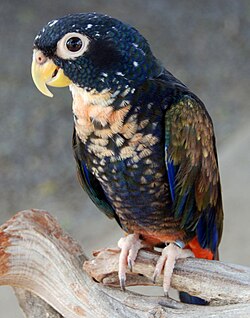| Image | Genus | Living species |
|---|
 | Pyrilia Bonaparte, 1856 | |
 | Pionopsitta Bonaparte, 1854 | |
 | Graydidascalus Bonaparte, 1854 | |
 | Alipiopsitta Caparroz and Pacheco, 2006 | |
 | Pionus Wagler, 1832 | |
 | Amazona Lesson, 1830 | - Cuban amazon, Amazona leucocephala
- Yellow-billed amazon, Amazona collaria
- Hispaniolan amazon, Amazona ventralis
- White-fronted amazon, Amazona albifrons
- Yucatán amazon, Amazona xantholora
- Black-billed amazon, Amazona agilis
- Puerto Rican amazon, Amazona vittata
- Tucumán amazon, Amazona tucumana
- Red-spectacled amazon, Amazona pretrei
- Red-crowned amazon, Amazona viridigenalis
- Lilac-crowned amazon, Amazona finschi
- Red-lored amazon, Amazona autumnalis
- Diademed amazon, Amazona diadema
- Blue-cheeked amazon, Amazona dufresniana
- Red-browed amazon, Amazona rhodocorytha
- Red-tailed amazon, Amazona brasiliensis
- Festive amazon, Amazona festiva
- Yellow-shouldered amazon, Amazona barbadensis
- Turquoise-fronted amazon, Amazona aestiva
- Yellow-headed amazon, Amazona oratrix
- Tres Marías amazon, Amazona tresmariae
- Yellow-naped amazon, Amazona auropalliata
- Yellow-crowned amazon, Amazona ochrocephala
- Orange-winged amazon, Amazona amazonica
- Scaly-naped amazon, Amazona mercenarius
- Kawall's amazon, Amazona kawalli
- Southern mealy amazon, Amazona farinosa
- Northern mealy amazon, Amazona guatemalae
- Vinaceous-breasted amazon, Amazona vinacea
- Saint Lucia amazon, Amazona versicolor
- Red-necked amazon, Amazona arausiaca
- Saint Vincent amazon, Amazona guildingii
- Imperial amazon, Amazona imperialis
- Martinique amazon, Amazona martinica (extinct)
- Guadeloupe amazon, Amazona violacea (extinct)
|
 | Triclaria Wagler, 1832 | |
|







